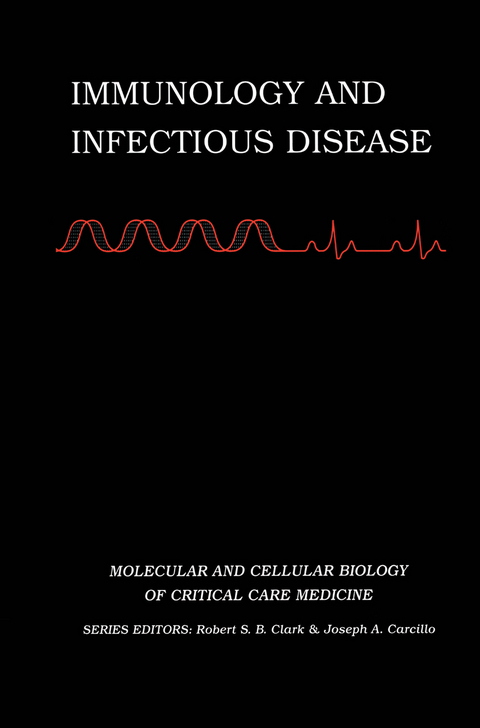
Immunology and Infectious Disease
Seiten
2002
|
2003 ed.
Springer-Verlag New York Inc.
978-1-4020-7307-6 (ISBN)
Springer-Verlag New York Inc.
978-1-4020-7307-6 (ISBN)
Provides a mechanistic look at key aspects of the inflammatory response seen in critical illness. This book emphasizes key cells and mediators involved in the innate inflammatory response and the pathways employed to combat infection or respond to injury. It includes the discussion of how the inflammatory response down regulates itself.
Individualized dosing regimens specific to the patient, infection, bacteria, and antibiotic can optimize outcome. Integration of pharmacokinetic and pharmacodynamic data, called dual individualization, can be accomplished through the use of AUIe. AUIC dosing has been shown to predict bacteriological outcomes, hasten clinical outcomes, reduce the emergence of resistance, and be cost-effective. MPC dosing has been shown to predict the emergence of resistant submutants. AUIC and MPC information can provide guidance as to when low doses can be used, and when higher concentrations are required. This strategy can ensure efficacy, minimize toxicity, reduce the opportunity for resistance to occur, and save money. REFERENCES I. Paladino JA. Streamlining antibiotic therapy: clinical application of pharmacokinetic and pharmacodynamic principles. J Osteopath Med 1991; 5: 16-25. 2. Liss RH, Batchelor FR. Economic evaluations of antibiotic use and resistance - a perspective: report of task force 6. Rev Infect Dis 1987; 9 (suppI3): S297-312. 3. Holmberg SO, Solomon SL, Blake PA. Health and economic impacts of antimicrobial resistance. Rev Infect Dis 1987; 9: 1065-78. 4. Sanders cc.
Mechanisms responsible for cross-resistance and dichotomous resistance among the quinolones. Clin Infect Dis 2001; 32(Suppl I ):S 1-8. 5. Ballow CH, Schentag 11. Trends in antibiotic utilization and bacterial resistance: report of the NNRSG. Diagn Microbiol Infect Dis. 1992; 15(suppl):37S-42S. 6. Rice LB, Eckstein EC, DeVente J, Shlaes OM. Ceftazidime-resistant Klebsiella pneumoniae isolates recovered at the Cleveland Department of Veterans Affairs Medical Center. Clin Infect Dis 1996; 23: 118-24.
Individualized dosing regimens specific to the patient, infection, bacteria, and antibiotic can optimize outcome. Integration of pharmacokinetic and pharmacodynamic data, called dual individualization, can be accomplished through the use of AUIe. AUIC dosing has been shown to predict bacteriological outcomes, hasten clinical outcomes, reduce the emergence of resistance, and be cost-effective. MPC dosing has been shown to predict the emergence of resistant submutants. AUIC and MPC information can provide guidance as to when low doses can be used, and when higher concentrations are required. This strategy can ensure efficacy, minimize toxicity, reduce the opportunity for resistance to occur, and save money. REFERENCES I. Paladino JA. Streamlining antibiotic therapy: clinical application of pharmacokinetic and pharmacodynamic principles. J Osteopath Med 1991; 5: 16-25. 2. Liss RH, Batchelor FR. Economic evaluations of antibiotic use and resistance - a perspective: report of task force 6. Rev Infect Dis 1987; 9 (suppI3): S297-312. 3. Holmberg SO, Solomon SL, Blake PA. Health and economic impacts of antimicrobial resistance. Rev Infect Dis 1987; 9: 1065-78. 4. Sanders cc.
Mechanisms responsible for cross-resistance and dichotomous resistance among the quinolones. Clin Infect Dis 2001; 32(Suppl I ):S 1-8. 5. Ballow CH, Schentag 11. Trends in antibiotic utilization and bacterial resistance: report of the NNRSG. Diagn Microbiol Infect Dis. 1992; 15(suppl):37S-42S. 6. Rice LB, Eckstein EC, DeVente J, Shlaes OM. Ceftazidime-resistant Klebsiella pneumoniae isolates recovered at the Cleveland Department of Veterans Affairs Medical Center. Clin Infect Dis 1996; 23: 118-24.
1. Host Microbicidal Actions of the Innate Immune Response.- 2. Activation of the Innate Immune Response in Critical Illness.- 3. Down-Regulation of the Immune Response.- 4. Mechanisms of Pharmacologic Immune Suppression.- 5. Modulation of the Immune Response in Critical Illness/Injury.- 6. Immune Monitoring and Strategies for Immune Modulation.- 7. Central Venous Catheter Related Infections: The Role of Antimicrobial Catheters.- 8. Discrimination of True Lower Respiratory Tract Infection in the Mechanically Ventilated Patient.- 9. Detection of Urinary Tract Infection in the Catheterized ICU Patient.- 10. Antimicrobial Choices and Dosing Strategies to Maximize Efficacy and Minimize the Development of Bacterial Resistance.
| Erscheint lt. Verlag | 31.12.2002 |
|---|---|
| Reihe/Serie | Molecular & Cellular Biology of Critical Care Medicine ; 3 |
| Zusatzinfo | IX, 276 p. |
| Verlagsort | New York, NY |
| Sprache | englisch |
| Maße | 155 x 235 mm |
| Themenwelt | Medizin / Pharmazie ► Medizinische Fachgebiete ► Intensivmedizin |
| Studium ► Querschnittsbereiche ► Infektiologie / Immunologie | |
| ISBN-10 | 1-4020-7307-0 / 1402073070 |
| ISBN-13 | 978-1-4020-7307-6 / 9781402073076 |
| Zustand | Neuware |
| Haben Sie eine Frage zum Produkt? |
Mehr entdecken
aus dem Bereich
aus dem Bereich
Buch | Softcover (2023)
Lehmanns Media (Verlag)
19,95 €


